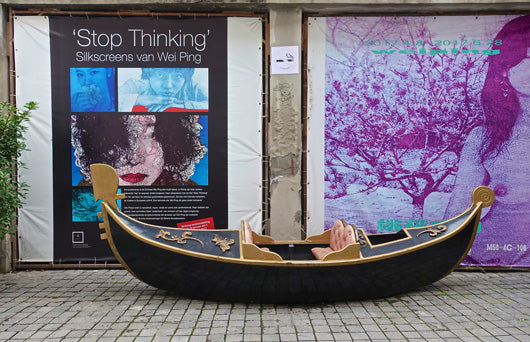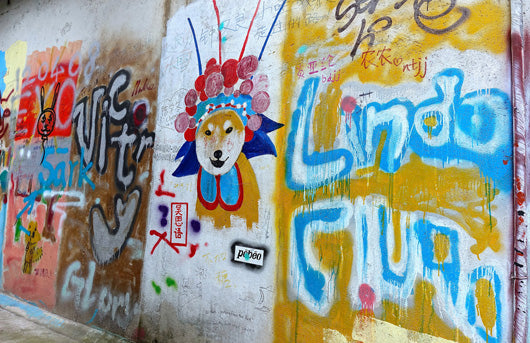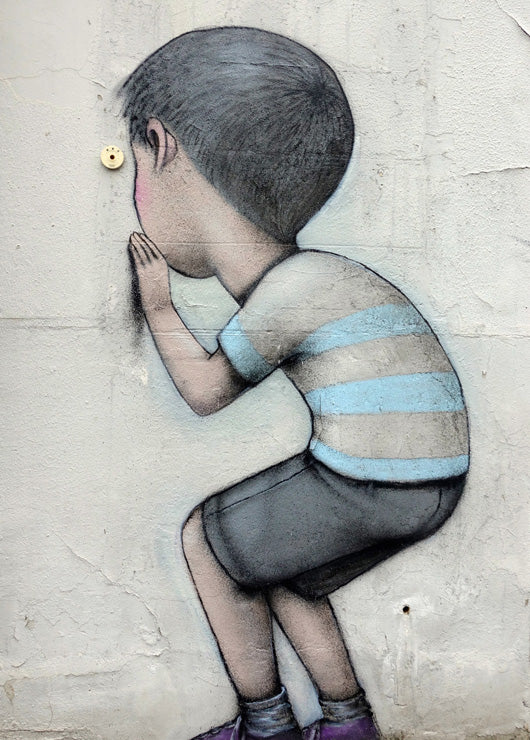
For all the buzz about Shanghai’s explosive contemporary art scene, typically “subversive” forms such as graffiti and street art remain predictably constrained expressions, limited to the inside of privately owned exhibition spaces such as the MoCA Shanghai show that closed this week spotlighting international stars such as Shepard Fairey and Zevs.
Otherwise, the very effective threat of fines and even jail time are enough to preserve the unspoiled shades of grey that typify this concrete megalopolis, the world’s second most populous. Well, that is outside the skyline at the Bund, a Technicolor digitally powered sensory overload, which promptly goes dark at 10pm nightly—even on a Saturday night, as Andy and I discovered during our recent weeklong trip there to visit Stellar Works. While we can see the benefits in keeping swaths of city, any city, graffiti free, there is also something about the writing on the wall which can reveal and relay so much about a place and time.
One corner that has managed to fly its freak flag is Moganshan Lu, known widely these last couple of decades as the M50 Arts District. A labyrinth of former textile mills, a handful of artists began colonizing the abandoned buildings—and saturating the very public walls in boldly bombed and, somewhat, thematic works. In the years since, galleries, studios, cafes and a few boutiques have come and gone, along with tourists, mostly with cameras and a few with their own cans of spray paint to add to the visual cacophony.
All of this has thrived with government sanction, of course. A wall at the main entrance is dotted with a handful of gleaming official plaques to prove it. Uniformed police are fewer than, say, along the Huangpu River, the city’s landmark greyish-blue thoroughfare. But their presence is still plain.
Even with the official “creative zone” stamp, graffiti and street artists continue to create outside the zone of respectability. Sourcing quality outdoor spray paint remains a hard to come by and scoring imported product is par for the course. Some practitioners have gone so far as try to re-brand themselves as aerosol artists.
And, like all cheap arty enclaves around the world, M50 is not immune to the forces of urban renovation and real estate interests. The complete erasure of the much-Instagrammed graffiti’d wall along Moganshan Road has been reported and rumored under threat for at least a decade.
Those promises appear to be coming true, as chunks have been knocked down in recent years, and graffiti enthusiasts worldwide have urged fellow fans to document it all before it disappears completely. District authorities insist a new graffiti wall along a walking trail is part of the area’s extensive urban redevelopment plan.
In the meantime, there is enough unfettered work to be enjoyed throughout M50. Not everything is particularly good or memorable. But that’s not the point.
We meandered the warren of back lanes during a grey afternoon, thrilled to see the pops of color and creativity concentrated here by local and visiting artists alike. We fortunately caught the final hours of MoCA’s wonderful solo spotlight on the childlike explorations of the French street artist Seth (nee Julien Malland). We had tea with an Italian-born colleague living in Toronto. In a megacity defined as much by its kinetic energy as its state of surveillance, there was a spark here. A very human one.










